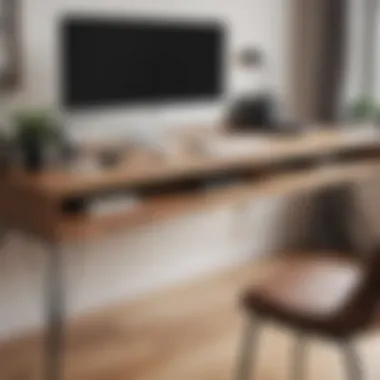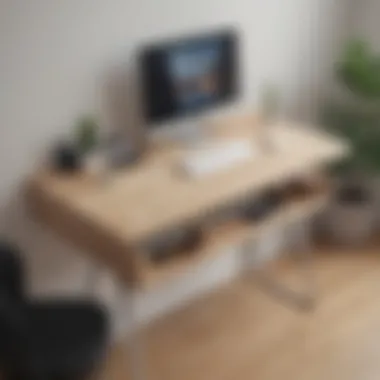Choosing an Affordable Computer Desk: Key Insights


Intro
Selecting an affordable computer desk often feels like searching for a needle in a haystack. The challenge isn't just about price, but also how well the desk fits your needs and enhances your workspace. With countless options, styles, and features available today, it’s no wonder that potential buyers may feel a bit overwhelmed. This article isn’t just about finding the cheapest option; it's about finding the right one for you, striking that perfect balance between cost and comfort.
In today’s fast-paced world, where remote work and online schooling have become the norm, having a suitable workspace is essential. A good desk can foster productivity and offer an environment that encourages focus. Whether you're a student, a professional hustling to meet deadlines, or simply someone who dabbles in DIY projects, your desk plays a significant role in how you operate.
The aim here is not to merely compile a list of options but to delve deeper into how to evaluate them based on your unique circumstances. You'll learn about various furniture styles, materials, and practical tips to make the right choice. Along the way, we'll address how to maintain these desks to ensure you get the most out of your investment. So grab a cup of coffee and let’s get started on this journey to finding the best inexpensive desk that suits your lifestyle and work habits.
Understanding Your Needs
Choosing a computer desk isn't just about grabbing something that looks nice. Understanding your needs lays the groundwork for a decision that will impact your daily comfort and productivity. Each individual has different requirements based on their work style, space constraints, and personal preferences. Recognizing these factors can help ensure that you don’t end up with a piece of furniture that doesn’t serve its intended purpose or fit well in your environment.
In essence, this phase involves conducting a thorough examination of the conditions and factors relevant to your workspace. This might sound straightforward, but skipping this step can lead to regrets down the line. Here’s where a bit of prep work pays off, potentially saving you both time and money in the long run.
Identifying Your Workspace Requirements
First things first—what will you be using the desk for? Is it for gaming, studying, remote work, or crafting? These tasks each come with specific requirements. For instance, a student may prefer a compact desk that can accommodate a laptop and some books, while a graphic designer might need a more spacious surface for design software and additional monitors.
When identifying your workspace needs, keep the following in mind:
- Usage Frequency: How many hours a day will you spend at the desk? Long hours demand ergonomic support.
- Necessary Equipment: Laptops, monitors, printers—what do you need to support your work?
- Personal Comfort: Do you often switch positions? Consider a desk that allows for flexibility.
Assessing Available Space
Now that you've pinpointed how you'll use your desk, let’s talk space. One of the biggest mistakes people make is choosing a desk without truly understanding the dimensions of the area it will occupy. It’s essential to measure your space carefully, taking into account not just the area where the desk will sit but also access to power outlets and the flow of movement.
Consider these aspects:
- Room Size: Is it an expansive home office or a cozy corner in your bedroom?
- Accessibility: Will the desk block pathways or make it difficult to reach other furniture?
- Natural Light: Positioning your desk near a window might enhance your mood, but glare on screens can be a hassle.
To visualize the layout, you might even sketch it out or use some free online tools to map things out.
Determining Desk Functionality
Functionality is the backbone of any desk choice. This phase dives into the versatility and practicality of the desk. What features are essential versus nice-to-have?
Consider the following when determining functionality:
- Storage Needs: Will you need drawers for supplies? An open workspace may work for some, but others thrive with structured organization.
- Adjustability: Is a standing desk a preference? These can be great for health-focused setups.
- Multi-use: Can the desk transition easily from work hours to creative endeavors? Multi-functional designs can add value.
Ultimately, understanding your needs grants you the clarity necessary to make a sound investment in a computer desk. Not only does it influence your choice but aid in defining what your workspace can transform into, turning it into a place where creativity flows and productivity thrives.
Key Desk Styles
When it comes to selecting an inexpensive computer desk, understanding the various desk styles can make all the difference. Each style carries its own unique aesthetic and functionality that can cater to different needs and preferences. Choosing the right one isn’t just about how it looks; it’s also about how it fits into your life, complements your space, and meets your work demands. Key desk styles range from traditional to modern minimalist designs, multi-functional workstations, and corner desks. It’s insightful to explore these options in depth.
Traditional Desks
The classic traditional desk evokes a sense of familiarity and reliability. Typically made from sturdy woods like oak or cherry, these desks often come with ornate details like carvings or inlays. One of the understated perks of a traditional desk is its adaptability. They fit well in various decor settings, offering a certain timeless charm.
- Benefits:
- Durable construction, which stands the test of time.
- Often includes built-in storage options, making organization easier.
- Aesthetic appeal can enhance the overall look of your workspace.
While they may cost a tad more than modern styles, fewer can match the enduring quality and character that a traditional desk provides. If you're after a desk that merges elegance with functionality, this style has much to offer.
Modern Minimalist Designs
The modern minimalist desk cuts through clutter with its sleek lines and uncluttered approach. Often crafted from wood, metal, or a combination, these desks emphasize function without unnecessary frills. The design philosophy here is that less is indeed more. Minimalist desks often come in neutral colors, making it simpler for them to blend into almost any environment.
- Considerations:
- Can save space, ideal for smaller areas.
- Encourages a tidy workspace, promoting better focus.
- Often lightweight, making them easier to move if needed.
If you prefer clean aesthetics and an uncluttered working environment, these desks can serve as the perfect backdrop for your creativity and productivity.
Multi-functional Workstations
Considering the dynamic nature of our work and needs, multi-functional workstations have gained traction. These desks aren’t just work surfaces; they can transform at a moment’s notice. With layouts that facilitate both work and play, you might find desks that convert into standing workspaces or have compartments that store away gadgets and supplies.
- Advantages:
- Versatility for varied tasks, from office work to crafting or gaming.
- Can optimize space, especially in a small apartment or home office.
- Often come equipped with features like built-in power outlets and USB ports.
If you juggle several activities in your workspace, this may be the style that elevates your efficiency and helps keep everything organized.
Corner Desks
Maximizing space is often a priority for many. Corner desks are designed specifically to utilize those often-neglected corners of a room. They can provide ample workspace while accommodating other furnishings without feeling crowded. Plus, their unique shape can make your work area look distinct and tailored.
- Benefits:


- Make good use of otherwise wasted space.
- Often boasted with ample storage solutions.
- Encourage a dedicated work environment by separating it from the rest of the room.
If you’re short on space and eager to create a workspace that balances style with functionality, corner desks can be an astute choice.
"The right desk can not only enhance your workspace aesthetically but can also boost productivity when it meets your specific needs."
With a myriad of styles to choose from, each desk type has its own strengths. Taking the time to examine these styles based on your personal needs and workspace requirements ensures that you find the ideal inexpensive computer desk that meets both your budget and your lifestyle.
Material Considerations
When it comes to selecting an inexpensive computer desk, the materials used in construction hold a hefty amount of significance. The material impacts not just the aesthetic appeal of the desk, but also its durability, stability, and functionality. Skimping on material quality might save a few bucks initially, but it can lead to higher costs in replacements or repairs down the line. Understanding the various materials available is pivotal to making an informed choice that aligns with your specific needs.
Wood vs. Metal
Choosing between wood and metal is akin to choosing between a warm embrace and a sturdy handshake. Wood desks often bring a level of charm and warmth to a workspace, and they can fit seamlessly into a variety of decor styles, from rustic to contemporary. On the other hand, metal desks project a more modern vibe and are typically more durable, especially under heavier loads.
- Pros of Wood:
- Pros of Metal:
- Warm aesthetic that can enhance the feel of your space.
- Often easier to modify or repair.
- Available in various types like oak, pine, and walnut, allowing for customizable choices.
- Generally more robust and can withstand wear and tear.
- Resistant to certain environmental factors, such as humidity, which can warp wood.
- Sleek and modern look that suits minimalist designs well.
Both materials have their charm; it boils down to personal preference and how each fits into your workspace needs.
Particle Board: Pros and Cons
Particle board desks are often dubbed as the budget-friendly option, but they come with a set of advantages and disadvantages that are worth dissecting. Made from smaller wood particles bonded together, this material can be a cost-effective alternative to solid wood.
Pros:
- Cost-efficient: Great for those watching their budget.
- Lightweight: Easier to move and handle, perfect for students or frequent movers.
- Versatility in design: Available in many finishes, designs, and can mimic the look of more expensive materials.
Cons:
- Durability issues: Not as strong as solid wood or metal, and can be prone to damage.
- Water sensitivity: Can swell or warp if exposed to moisture, leading to potential problems in humid environments.
- Less customization: Once assembled, altering or repairing can be less straightforward.
In essence, while particle board can save some cash, one must weigh its longevity against its initial low cost.
Glass Desks: Style Meets Functionality
Glass desks have poised themselves as a stylish option that injects a modern flair into any setting. They blend seamlessly with various materials, creating a sophisticated workspace atmosphere. However, it’s paramount to understand both their aesthetic benefits and practicality when considering a glass desk.
Advantages:
- Visually appealing: Open designs promote a feeling of space, making them ideal for smaller rooms.
- Easy to clean: Surface can be easily wiped down, which is appealing for those who prioritize hygiene.
- Versatility: Can fit with numerous styles, from contemporary to industrial.
Considerations:
- Fragility: Though tempered glass is stronger than traditional glass, it's still more prone to breakage compared to wood or metal.
- Weight capacity: May struggle under heavy loads, which can be a crucial factor depending on your computer setup.
- Fingerprints and Smudges: They can attract marks, necessitating regular maintenance to keep looking their best.
Ultimately, glass desks can certainly elevate the look of your workspace; just be cautious of their limitations in durability and weight capacity.
Choosing the right material for your desk is like picking the right foundation for a house; it sets the stage for everything else.
Features to Look For
When on the hunt for a budget-friendly computer desk, it’s not just about the price tag. The features a desk comes with can make or break your working experience. People often overlook the significance of specific elements like adjustable height, storage solutions, and cable management. Not only do these aspects enhance functionality, but they can also contribute to a more organized and comfortable workspace. To keep your environment conducive to work or study, let’s explore these features further.
Adjustable Height Options
In recent years, the trend of having adjustable-height desks has risen dramatically. This isn’t merely a passing fad; it addresses a genuine concern regarding ergonomics in the workspace. With the kind of jobs people have nowadays, sitting for extended periods can take a toll on health. Adjustable height options allow users to switch between sitting and standing, promoting better posture and reducing the risk of discomfort or injury.
- Benefits of Adjustable Height:
- Encourages movement throughout the day.
- Helps to alleviate back pain.
- Can improve mood and productivity levels.
You don’t need a bank-breaking desk to commit to your health. Many affordable desks nowadays offer this flexibility. Look for desks that are easy to adjust manually or have an electric option for seamless transitions.
Storage Solutions: Shelves and Drawers
The ability to have organized storage is crucial, especially if you’re someone who has a lot of paperwork, books, or gadgets scattered around. Here, the role of shelves and drawers comes into play. They not only help keep your workspace tidy but can also significantly impact your efficiency.
- Key Features of Effective Storage:
- Drawers: Ideal for stowing away items you don’t need immediately, like documents, tools, or stationery.
- Shelves: Perfect for displaying essential materials or decorative items, thus personalizing your space.
- Combination Options: Desks that integrate both features maximize your use of vertical and horizontal space.
Having dedicated spots for your items reduces clutter and allows your creativity to flow better. You’d be surprised how adding a few well-placed drawers or shelves can transform a chaotic workstation into a focused environment.
Cable Management Systems
Let’s not sugarcoat it—cables can be a nightmare. They tangle, they clutter, and they make even the sleekest setup look disorganized. That’s where cable management systems come into play. Having a desk designed with built-in cable management makes it easier to maintain a clean workspace.


- Considerations for Effective Cable Management:
- Cable Holes: Look for desks that offer holes or conduits to pass cables through, keeping them out of sight.
- Cable Trays: Some desks come with trays or hooks underneath for coiling and securing cables.
- Interior Channels: Desks with hidden channels mean you can have a tangle-free experience without visible cords.
By investing in desks that incorporate these management systems, you not only enhance aesthetics but also create a safer environment that minimizes the risk of accidents.
Synchronizing all these features provides a holistic solution towards creating an effective workstation that exemplifies both functionality and style.
In summary, each of these features plays a pivotal role in making your workspace more functional. Finding a desk that caters to your specific needs doesn’t have to be complicated. Focus on adjustable height options for flexibility, ample storage for organization, and efficient cable management to keep things tidy. All these elements will contribute to a workspace where you can thrive.
Budget Constraints and Strategies
When looking for a computer desk that won’t break the bank, understanding your budget constraints and strategies is as essential as picking the right aesthetic or material. An affordable price tag doesn’t have to mean sacrificing quality. What it comes down to is a systematic approach to outlining what you need versus what you can spend.
The first key element to consider is clearly defining your budget limit. This doesn't just mean deciding on a number, but also being aware of the hidden costs that might crop up along the way. Delivery fees, taxes, or assembly costs can add up, making that bargain desk priced attractively low feel not so appealing once you're at the checkout. Therefore, having a snug figure in your mind helps you avoid financial pitfalls and supports more streamlined decision-making when the time comes to make a purchase.
Setting a Realistic Budget
Establishing a realistic budget involves more than just looking at numbers abstractly. It’s about doing some homework. Ask yourself:
- What desk features are non-negotiable for your work?
- How often will this desk be used?
- Can you compromise on certain aspects without feeling deprived of functionality or aesthetics?
When setting a budget, consider a range that includes lower-end options as well as the potential for a splurge if you find something that ticks all the boxes. A solid guide might be to allocate between $100 to $300 for a decent desk. This gives you some room to maneuver but also keeps potential flab off the spreadsheet. Don’t forget to factor in possible upgrades or accessories you might want later on, which can quickly add up if you're not careful.
Identifying Cost-effective Brands
Once the budget is set, it’s time to scout for brands that align with your financial parameters. Not every brand worth its salt has to command a king's ransom. Some well-known players in the budget desk realm include IKEA, Sauder, and Altra. But be on the lookout for lesser-known names that provide good value without the price tag that comes with market-dominating options.
Here are a few aspects to note when scouting brands:
- Read reviews to gauge quality versus cost. Sites like Reddit and specialized furniture forums often provide real user experiences.
- Opt for brands that offer warranties or satisfaction guarantees; this can save a few headaches down the line.
- Don't overlook local businesses. Sometimes mom-and-pop shops have great options that beat the big-box stores not only in pricing but in quality, too.
Shop During Sales and Promotions
Timing your purchase can be just as critical as the decision itself. Major holidays, seasonal changes, and even black Friday sales can present suitable opportunities for snagging a desk at a price that feels like a steal. Follow your preferred retailers on social media or subscribe to newsletters to get notified of ongoing sales.
With this strategy in hand, you can get an excellent deal without sacrificing the quality you desire. Also, consider checking out clearance sections, as they may house some hidden gems at significant discounts.
"Keeping an eye on sales can turn a pricey purchase into an affordable investment."
In summary, while it’s vital to embrace the aesthetics and the functionality of a computer desk, never underestimate the importance of budget constraints and strategic planning. By setting a realistic budget, identifying cost-effective brands, and timing your purchases right, it’s entirely feasible to strike a balance between quality and affordability.
Where to Buy
When it comes to selecting a computer desk that fits your budget, knowing where to buy is crucial. Each purchasing avenue has its unique perks, and understanding these can lead you to the best options without breaking the bank. Factors such as product variety, pricing, and accessibility can greatly influence your buying experience.
Online Retailers vs. Brick-and-Mortar Stores
Deciding between online platforms and physical stores is like weighing apples against oranges. Online retailers often present a broader selection, making it easier to compare prices and styles at your leisure. Websites like Amazon, Wayfair, or IKEA allow you to explore reviews and ratings, providing insights from previous buyers. You can sit in your pajamas, sip on coffee, and scroll through hundreds of desks. The downside? You can’t physically touch the product or see how it fits in your space until it arrives.
On the other hand, visiting a brick-and-mortar store can be enlightening. You can examine countertops, experience the sturdiness of a model, and ascertain if that sleek design meshes well with your room’s aesthetics. You also avoid potential shipping issues—no risks of receiving a desk with a dent or scratch. However, local stores might limit your choices, sometimes forcing you to pay a bit more. It’s a balancing act; considering the pros and cons before you decide is essential.
Local Furniture Stores
Local furniture stores can be gems in the quest for a good computer desk. Often, these places support small businesses and offer unique pieces that you won’t find on larger retail websites. Wandering through local shops gives you a chance to discover one-of-a-kind designs or vintage desks that might fit perfectly with your style.
While you may find that opting for local stores can incur a higher price tag, many also have excellent deals or discounts, especially on floor models or displays. Plus, supporting local businesses fosters community growth. Just remember to verify if the desk’s quality meets your standards regarding durability and comfort. Sometimes, they will also assist you with finer details like delivery, which is beneficial when purchasing heavier items.
Second-hand Shops and Thrift Stores
Venturing into second-hand shops and thrift stores is akin to a treasure hunt. You never know what you might find. One day it could be a classic oak desk with character that simply needs a bit of polishing; the next day, maybe a modern piece barely used. The thrill of discovering a high-quality desk at a fraction of the retail price is hard to replicate.
When selecting second-hand options, though, a keen eye is needed. Be on the lookout for signs of wear that may impact longevity—wobbly legs or chipped surfaces can be flags. With a bit of creativity, you might even personalize your find, transforming it into a striking centerpiece for your workspace. As an added bonus, buying second-hand supports sustainability efforts, as it gives furniture a new lease on life.
Engaging with your local thrift stores can not only save some bucks but also lead to unexpected discoveries.
Ultimately, where you buy your computer desk can be just as pivotal as the desk itself. Weigh the options and consider what matters most for your needs—whether it's immediate availability, craftsmanship, or budget constraints, each pathway has its distinct flavor.
Assembly and Setup
Choosing the right desk is only half the battle; ensuring that it’s properly assembled and set up is crucial for both functionality and aesthetics. When you invest in a budget-friendly computer desk, understanding the assembly and setup process can save time, frustration, and even the risk of damaging your new purchase. After all, a desk serves as your primary workspace; it ought to be stable and organized to foster productivity.
Understanding Assembly Requirements
When you acquire a new desk, it usually comes in a box with an assortment of parts and hardware. The first step is comprehending what exactly you need to do for assembly. Measurement details and specifications are often included in the manual. Pay particular attention to how parts are labeled and which screws go where. Some manufacturers, like IKEA, provide clear diagrams that can be exceptionally handy via visual aid rather than relying solely on words.
Being aware of any weight limits or specific assembly protocols can prevent future headaches. For instance, if you overlook the weight capacity of shelves, you may find yourself with a broken desk and scattered office supplies before you know it. The key takeaway here is to approach assembly like a puzzle; take your time, ensure you have all pieces, and follow the provided instructions closely.
Tools Needed for Setup
Depending on the desk design, the tools required can range from minimal to extensive. Most inexpensive desks will need just a few basic tools, which might include:


- Screwdriver (often Phillips or flathead, depending on the screws provided)
- Allen wrench (sometimes included as a bonus with furniture)
- Hammer (for special fasteners, if needed)
- Leveling tool (to ensure that the desk sits straight)
Take stock of what you have at home before committing to the assembly. You don’t want to find out mid-way through that your toolkit is lacking some essentials.
Instruction Clarity and Ease of Installation
Clear instructions are a blessing. Sometimes they aren’t up to snuff. If instructions are too vague or challenging to understand, it can lead to mistakes that could cost both time and satisfaction with your desk.
Utilizing kits with well-articulated assembly guidelines allows you to piece together your desk with confidence. Additionally, many brands offer setup videos online, which can be a lifesaver for visual learners.
However, if faced with poor instruction clarity, don’t hesitate to take matters into your own hands. Online forums, like those on Reddit, often have users sharing their own tips on specific products. These shared experiences can provide solutions and possibly avert unnecessary frustration.
Remember: Assemble on a soft surface like a carpet or blanket to avoid scratching parts before they are fully configured.
In short, a little forethought goes a long way when it comes to assembling and installing your computer desk. Taking the time to understand the requirements, equipping yourself with the right tools, and ensuring that instructions are clearly laid out sets the foundation for a successful setup.
Maintenance and Care
Maintaining your computer desk isn't just about aesthetics; it plays a crucial role in ensuring longevity and functionality. Regular care can fend off major issues down the line, saving both money and frustration. A good maintenance routine helps keep your workspace inviting while preventing deterioration caused by dust build-up or wear and tear. Given that many individuals spend hours working at their desks, a clean and well-maintained environment is essential for productivity and mental clarity.
Keeping your desk in tip-top shape starts with understanding which cleaning materials suit your specific desk type. Some finishes are more delicate than others, and using the wrong cleaner can create irreversible damage. Additionally, preventative care measures can extend the lifespan of your desk, making your investment more worthwhile than it initially seemed. By staying ahead of potential pitfalls, you will ensure your workspace remains functional and visually appealing.
Cleaning Materials and Techniques
When it comes to cleaning, the materials you choose matter significantly. Certain cleaning solutions might work wonders on glass surfaces, but can be detrimental to wood finishes. Here’s a handy guide:
- For Wooden Desks: A soft cloth with a mix of warm water and mild soap is generally safe. Avoid excess moisture, as it can warp the wood. Additionally, you can occasionally apply a wood conditioner to maintain its natural envelope.
- For Glass Desks: Standard glass cleaner works well. Use a microfiber cloth to avoid streaks and scratches. Just ensure that your desk doesn’t have any fragile decorative elements that could get damaged.
- For Metal Desks: A damp cloth and some mild detergent typically do the trick. Rinse thoroughly to avoid lingering soap residues.
Over the years, I've discovered that a regular cleaning schedule helps to keep surfaces pristine. Rather than waiting for accumulation, a quick wipe-down every couple of weeks keeps everything looking new.
Preventative Care for Longevity
Preventing issues before they arise can be a game changer. You don’t need to turn into an overly cautious caretaker, but a few simple habits can go a long way. Consider these strategies to extend your desk's life:
- Avoid Direct Sunlight: Placing your desk away from windows or using curtains can prevent fading and heat damage. Sunlight may look pleasing, but it can age surfaces faster than you’d like.
- Use Coasters and Mats: Always place coasters under drinks and mats under devices. This prevents direct contact and reduces risks of scratches or moisture damage.
- Regularly Check Hardware: Tighten screws and joints as part of your maintenance routine. Over time, things can loosen up, leading to instability, which, in turn, could result in wear.
- Avoid Clutter: While it’s easy to let papers pile up, keeping surfaces clear can prevent undue stress on them. Less clutter means less mixing of materials that could cause scratches.
Adopting these maintenance habits not only preserves your desk but also enhances your overall workspace experience, making it both a functional and aesthetically pleasing area.
Customization Options
In today's fast-paced world, personalizing your workspace isn’t just a luxury; it's a necessity. Customization options allow you to transform an ordinary, inexpensive computer desk into something that reflects your unique style and meets your specific needs. It is imperative to understand that the right custom touches can enhance productivity, add character to your workspace, and even boost your mood while working.
Personalized Accessories
Personalized accessories serve as the icing on the cake when it comes to desk customization. Think beyond the basics; it's about turning that desk into a true representation of you. These accessories can range from aesthetically pleasing items to highly functional additions.
Here are some examples of what you can consider:
- Desk Organizers: These come in various colors, materials, and designs. They help in keeping your workspace tidy while offering a personal flair. Some organizers even have sections for specific items like pens, papers, and even tech gadgets.
- Keyboard and Mouse Pads: Choose vibrant colors or patterns that resonate with you. These accessories not only enhance comfort during use but also add a splash of personality to your workspace.
- Lighting Solutions: Desk lamps with adjustable brightness not only provide optimal lighting for work but can also be selected to match your style—be it sleek modern or a bit rustic.
These personalized choices enable you to create an environment that resonates with you, making your desk more inviting.
DIY Enhancements
If you take pride in crafting your own workspace, DIY enhancements can be an engaging way to add that personal touch. You don’t have to be a woodworking expert to implement these ideas, as many are simple and can be accomplished with basic materials.
Here are a few enhancements to consider:
- Paint or Stain: A simple coat of paint or a stain can do wonders. You could repaint the desk to a color you love or apply a stain to bring out the natural wood grain, making it look more high-end than it is.
- Vinyl Wraps: If you want to change the look of your desk without permanent alterations, consider using vinyl wraps. These can cover surfaces with designs that reflect your tastes—be it marble, wood textures, or funky patterns.
- Wall-mounted Shelving: Adding some shelves above your desk can enhance both storage and personalization. Fill them with books, framed photos, or quirky decor pieces that make you smile.
End
Ultimately, customization options are about expressing your own style while creating a degree of functionality that caters to your daily tasks. Personalized accessories and DIY enhancements aren’t just superfluous details; they play a crucial role in making your workspace productive and enjoyable. Taking the time to consider these aspects can transform an inexpensive desk into a unique haven for creativity and focus.
Customization is not merely an aesthetic endeavor; it’s about cultivating a conducive environment for both work and inspiration.
By exploring these options deeply, anyone from students to seasoned professionals can create a workspace that not only meets their needs but also inspires them daily.
Closure
As we wrap up this guide, it’s essential to reflect on why selecting the right inexpensive computer desk is so crucial. In today’s work and study environment, a well-chosen desk significantly influences productivity and comfort. It’s not just about finding something that fits your budget; it’s about finding something that meets your needs functionally and esthetically. A bad desk can lead to poor posture, distractions, and ultimately, less efficient work or study times.
Recap of Key Points
We’ve journeyed through several key considerations during our exploration:
- Identifying Workspace Requirements: Knowing what you require for your workspace is paramount. Are you a minimalist or do you need space for multiple devices?
- Material Considerations: The choice between wood, metal, or glass affects not only looks but durability as well.
- Features and Functionality: Whether you prefer adjustable heights or extra storage, the features of a desk can transform the way you work.
- Budget Strategies: Setting a clear budget, identifying brands that offer good value, and knowing when to shop can save you a significant amount of money.
- Maintenance: Post-purchase care prolongs the lifespan of your desk, making it a smart investment.
- Customization: Personal touches help shape a work environment that resonates with you, from colors to accessories.
Reflecting on these aspects can ensure that when you’re browsing through options, you’ll identify one that truly fits your lifestyle.
Final Thoughts on Choosing Inexpensive Desks
Choosing an inexpensive desk shouldn't feel like searching for a needle in a haystack. However, it can be daunting, especially with the variety of options available today. Keep in mind that the desk you select should serve your particular needs and should grow with you over time.
Think carefully about aspects like size, material, and functionality. It’s always a good idea to prioritize quality over a low price tag. Remember, spending a bit more on a durable desk could save you from needing replacements in the future. Don't shy away from second-hand options or looking online for deals. Every little bit helps when staying on budget.
Lastly, your workspace should inspire you. A desk can be the foundation of creativity and productivity. Personalization through DIY enhancements or unique accessories can reflect your style and keep you in high spirits while you work or study.
"A desk is not just a piece of furniture; it's your creative sanctuary. Choose wisely!"







